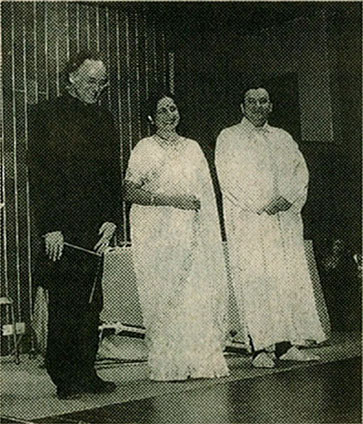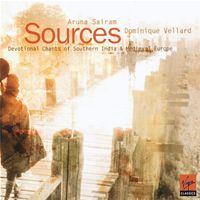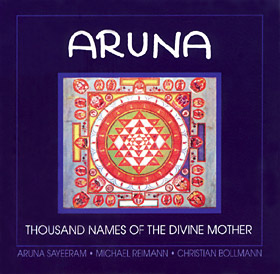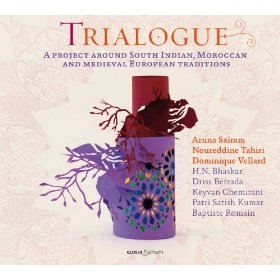Collaborative Creations
-

By Akhila Krishnamurthy
Sometime, in the early 90s, German duo, Christian Bollmann and Michael Reimann, teamed up with Chennai-based Carnatic musician, Padmashri Aruna Sairam to create a new sound of music. The dialogue translated into an album titled Aruna—Thousand Names of the Divine Mother that was recorded in the crypt of a chapel in Germany. “I sang the opening and closing pieces of the Lalitha Sahasranamam as Michael played the organ and Christian, the didgeridoo; the over layering of these sounds had a quality of the divine,” said Aruna Sairam.
Five years ago, Finnish music composer Eero Hameenniemi, who grew up with a “reverence for Indian classical music”, met Chennai-based classical vocalist, Bombay Jayashri, with the idea of a collaboration. “To my delight, she agreed instantly,” writes Eero, in an email interview from Kerava (Finland), “Over the last 15 years since I’ve known her, I’ve dreamt about how I could, some day, write music for her.” Eero realised that dream in 2007 when he composed pieces that combined the Finnish Philharmonic orchestra with Jayashri’s voice that belted verses (on love) from the Sangam poetry in five different ragams.
Six days ago, Padmashri Sudha Raghunathan, who lives in Chennai, shared stage space with well-known jazz musician Amit Heri from Mumbai. From an audience point of view, the coming together of two very different and disparate streams of music translated into an auditory treat that was unique, layered and meaningful. Alchemy, as their experiment is called, is really an interweaving of two sounds to create a new vocabulary. “It’s like weaving an altogether new pattern while highlighting the beauty of each, unique weave,” Sudha says, a day after the concert.
Traditionally, artistes are seekers, with an insatiable appetite for creativity and innovation. That pursuit is what is leading a handful of classical musicians in Chennai, in particular, to travel a path that is as new and unique as it is textured and testing. In the already vibrant repertoire of Carnatic musicians, the word varied is slowly becoming a constant. “Collaboration,” Aruna says, “is really a matching of a spirit; a meeting of vibrations that will result in a one-of-a-kind experience. Else, it’s pointless; it’ll end up sounding like shaking up marbles in a bottle.”
Collaboration, in a sense, almost always stems from an artiste’s urge to unearth and discover something new not only in his or her own music but also in the world of music as a whole. “Every form of music,” Sudha says, “has some quality of its own; an experiment like this allows you to appreciate it, dig deeper into your own genre and break out of the monotony of what you are always doing.”
T M Krishna, acclaimed Carnatic vocalist, whose last collaborative venture was a concert with Sudha Raghunathan, perceives experiments like these as “platforms that foster and encourage equal partnership among like-minded artistes”. “All artistes are, in a manner of speaking, self-obsessed,” he explains, “The creative process tends to be engulfing in itself. When you decide to share stage space with someone else, it helps you break that.” Krishna can also take credit for collaborating with the most number of Carnatic vocalists—wife, Sangeetha Sivakumar, Bombay Jayashri, Vijay Siva, Sudha Raghunathan—in addition to sharing stage space with Hindustani maestro, Rashid Khan. “Honestly, I think working with artistes in the same musicality is tougher than collaborating with a musician who represents another genre,” Krishna says. “In the case of the former, you are sharing the same idea, musicality with another individual with a clear identity and that’s not easy.”
Well-known Western classical pianist, Anil Srinivasan, who burst into Chennai’s musical scene six years ago with a musical aesthetic that married vocalist Sikkil Gurucharan’s voice with the beauty of the piano, views collaborations as processes that “teach me a lot of what I don’t know… I realise how much depth and how much work each of my collaborators have put into their lives”. Anil says in an email from Australia, where Gurucharan and he performed recently: “My collaborators have also opened doors for other musicians they have worked with and thereby made me spread my wings quite a bit.” The duo has already toured Korea and Malaysia this year. Anil’s musical wardrobe also prides itself on collaborating with versatile musicians like Chitravina Ravikiran,
U Srinivas and Lalgudi Krishnan.
Artistes unanimously acknowledge the process leading up to the performance almost as fruitful as the creation itself. Bombay Jayashri, who has performed with celebrated musician, Shubha Mudgal, as many as twelve times in addition to concerts with dancer and choreographer, Leela Samson, T M Krishna, to name a few, describes the process, as very “enjoyable”. “I remember this one time, Shubhaji sang a Hindi song on a ferryman who crosses a river, come rain or shine, and I juxtaposed it with poems on the river itself.”
For solo performers, a collaborative project may also mean following a set map that may, in a sense, restrict their quality of music. “There is an itinerary for sure; for instance, we know when Amit will go full flow with the guitar and I tone down and vice versa and when we both will meet and explode.” Aruna avers there is spontaneity but you “have to map it out. You need to know when you are going to fly and when you’ll let your partner do the same. It’s almost like marriage where there is a defined framework but there is freedom, no doubt. It’s also perhaps because the notion of freedom in marriages is being misconstrued that the divorce rate is on the rise.” But that subject is for another day. For now, let there be music; the more, the merrier!
Related Albums

Sources
Published : 2000
By : EMI Records / Virgin Classics - France
Aruna - Thousand Names...
Published : 1995
By : Lichthaus Music...
Trialogue
Published : 2012
By : Glossa Music
Related Concerts
- HEAVEN & EARTH at World Music Festival 2018
On : Sunday, February 11, 2018 - Sammohanam - A celebration of Music and Dance 2017
On : Sunday, February 19, 2017 - HEAVEN & EARTH at Sacred Music Festival 2018
On : Sunday, February 4, 2018 - Sammohanam - A celebration of Music and Dance 2017
On : Friday, February 17, 2017

 Photos
Photos PDF
PDF